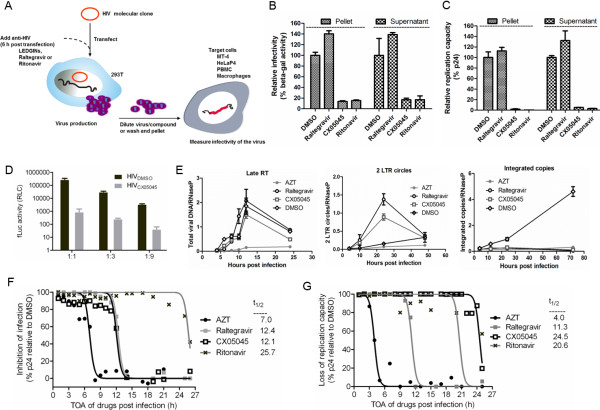Figure 2.
Systematic evaluation of the multiple effects of LEDGINs on HIV-1 replication. (A) Schematic representation of virus production and infectivity assays to determine the late effect of LEDGINs. (B, C) Detailed analysis of the late effect of LEDGINs on the replication of NL4.3 (B) in HeLaP4 cells as determined by measuring beta-galactosidase activity 24 hpi (mean values ± standard deviations; n = 2), (C) in MT-4 cells by measuring p24 72 hpi (mean values ± standard deviations; n = 2). (D) Infectivity of HIV-1-IN-eGFP/VSV.G pseudovirus [27] generated in the presence CX05045 (HIVCX05045) or DMSO (HIVDMSO) as measured by Firefly luciferase (fLuc) activity (mean values ± standard deviations of triplicate measurements for three dilutions of inocula normalized for p24 antigen are shown). (E) qPCR analysis for the kinetics of late RT product, 2-LTR circles and integrated copies in MT-4 cells are shown (mean values ± standard deviations of triplicate measurements are plotted). (F, G) Time-of-addition (TOA) analysis in MT-4 cells for (F) inhibition of single round replication determined at 31 hpi or (G) loss of replication capacity of the progeny virions was determined 4 dpi by p24 ELISA in the supernatants. Time (t1/2, h) of compound addition yielding 50% inhibition is indicated for each compound. As expected, AZT loses activity at 4–7 hpi and raltegravir at 11–12 hpi coinciding with RT and integration steps, respectively. Ritonavir affects p24 production and virus infectivity at around 20–26 hpi. CX05045 profiles as (F) an integration inhibitor (t1/2 = 12.2 h) when assaying single round infection, (G) whereas the late effect is evidenced only when measuring replication capacity of the progeny virions released in its presence (t1/2 = 24.5 h). Data represent normalized inhibition to the DMSO control (set at 100%).

